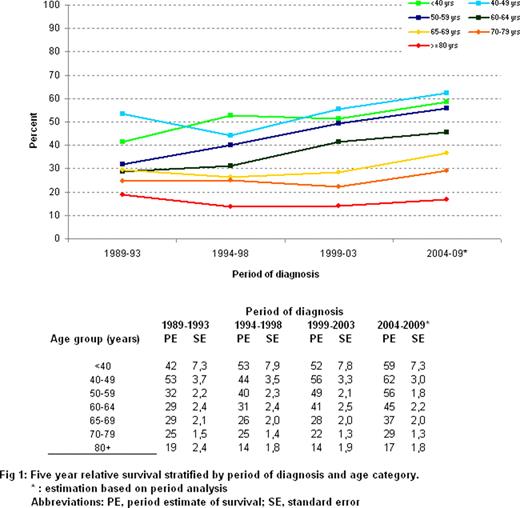Abstract
Abstract 5071
Multiple myeloma (MM) is de second most common haematological malignancy in adults worldwide. MM is common in the elderly. While the general life expectancy is increasing an ever increasing number of patients has to be expected. In the last decade treatment strategies are changed continuously because of the introduction of novel agents and allogeneic and autologous stem cell transplantation. In randomized controlled trials, overall survival in patients up to 65 years is improving convincing. In contrast with results in older patients. We studied data of patients treated outside clinical trials derived from the population based registry in the Netherlands to recognize trends in incidence en survival during 1989–2009.
We included all patients with newly diagnosed MM in the period 1989 – 2009 who were recorded in the Netherlands Cancer Registry (n =16.822 ). Follow-up was until January, 2010. We calculated the yearly age-standardised incidence rates for males and females and age-specific incidence rates in 10 year age groups for both sexes separately and combined. Changes in incidence were evaluated by calculating the estimated annual percentage change (EAPC). We then calculated relative survival, which may be interpreted as disease-specific survival within a cancer patient population. Traditional cohort-based, relative survival analysis was applied for patients diagnosed during 1989–2009. Since follow-up was available until 2010, 5 year relative survival for patients diagnosed in 2004–2009 was estimated using period-based relative survival analysis.
The number of newly diagnosed MM cases rose between 1989 and 2009 from 631 to 968 cases respectively. Significantly more males were diagnosed than females over time (p=0.01). Furthermore the proportion of male patients increased slightly over these time periods. However, the overall age standardised incidence rate for males and females remained stable over time but was higher among males than females.
The median age at diagnosis was 71 years (p10-P90 range 53–84) and stable over time (p=0.07). Incidence was highest in the 70–79 age group for both sexes. However, because of the aging population the age-specific incidence rates (ASIR) were highest for patients aged 80+ years for both sexes.
Within specific age groups significant changes were seen. In the population 50–59 years, the ASIR increased from 5.0 per 100,000 in 1989 to 6.9 in 2009 (EAPC 1989–2009 = + 0.7%; 95% CI: 0.0 –1.3). A decrease was seen in females aged 80+ years from 25.1 per 100,000 in 1989 to 22.4 in 2009 (EAPC 1989–2009 = −1,0; 95% CI: −1.8; −0.2).
In the overall patient population the 1-year relative survival increased only slightly from 72% to 77% between 1989 and 2009. 5-year relative survival increased from 28% to 37%. Small improvements in survival were observed for all age groups in the past two decades except for patients aged 80+ years.
Relative survival decreased with increasing age. In contrast, in the group aged 40–64 years improvements are already detectable from 1994 on. In 2004–2009 the highest 5-year relative survival, 62%, was seen in patients 40–49 year of age. However the strongest improvement over time was observed among the group 50–59 years.
Although the average annual age-adjusted incidence rate remained stable from 1989–2009, the number of newly diagnosed MM patients increased because of the aging population.
Relative survival increased slowly but continuously in time for patients until 80 years of age with strongest increase seen in patients up to 64 years of age. Improvement for these younger patients is most likely caused by the introduction of novel agents based regiments as well as by the introduction of high dose chemotherapy followed by stem cell transplantation. Our findings in trends of incidence and survival of MM are similar to those reported in other western populations.
Sonneveld:Celgene: Membership on an entity's Board of Directors or advisory committees, Research Funding; Janssen-Cilag: Membership on an entity's Board of Directors or advisory committees, Research Funding; Onyx: Membership on an entity's Board of Directors or advisory committees, Research Funding; Millennium: Membership on an entity's Board of Directors or advisory committees.
Author notes
Asterisk with author names denotes non-ASH members.



This feature is available to Subscribers Only
Sign In or Create an Account Close Modal